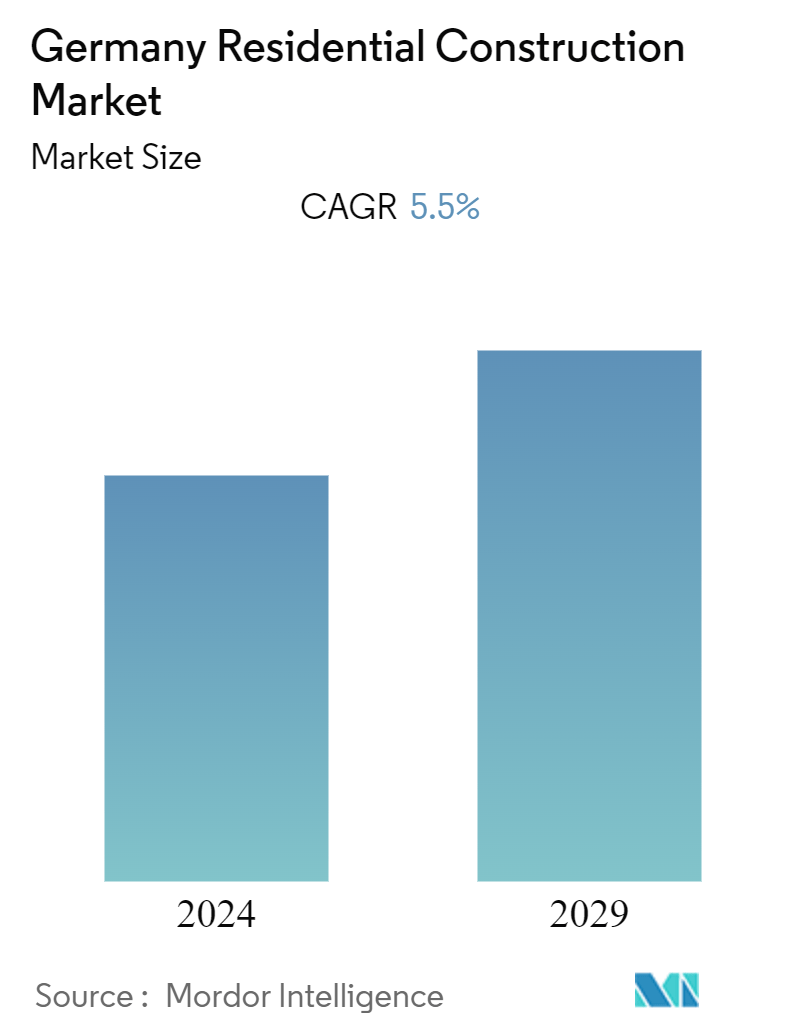Market Size of Germany Residential Construction Industry

| Study Period | 2020 - 2029 |
| Base Year For Estimation | 2023 |
| Forecast Data Period | 2024 - 2029 |
| Historical Data Period | 2020 - 2022 |
| CAGR (2024 - 2029) | 5.50 % |
| Market Concentration | Low |
Major Players
*Disclaimer: Major Players sorted in no particular order |
Need a report that reflects how COVID-19 has impacted this market and its growth?
Germany Residential Construction Market Analysis
The Germany Residential Construction Market is expected to register a CAGR of 5.5% during the forecast period.
The Germany Residential Construction market is driven by the huge number of immigrants residing in the country demanding new homes. Furthermore, the market is driven by government initiatives to provide affordable housing and fulfill the housing demand increasing in the country.
- Expectations for the construction industry in 2023 remain optimistic. This expectation must be revised in light of the conflict in Ukraine. At the moment, it is difficult to predict how the Russian invasion of Ukraine will affect the German construction industry. In some materials (steel for concrete reinforcement), nearly half of the material used comes from Russia or Ukraine. Until 2021, real construction investment increased by 39%, and the number of new flats and houses on the market more than doubled to more than 300,000 units. The most important reasons for this development have not changed during this time. A large number of immigrants, the record low mortgage rates, the extremely high demand for new apartments in agglomeration areas, the rising disposable incomes of private households and the search for investments with higher yields than the capital market has to offer.
- Furthermore, the government has significantly increased affordable housing subsidies. To ensure that the new affordable housing goals are met, the government has established a new ministry to oversee the sector's development. Based on current migration trends, Germany is expected to require at least 400,000 new housing units per year for the next decade or more. The publisher anticipates that the new government's increased emphasis on affordable housing and the need for new housing units due to increased migration will continue to support the country's industrial growth in the short to medium term. As a result, keep a positive outlook for the German residential construction sector over the next four to eight quarters.
- The German housing market has been remarkably strong for decades, but it faces a significant price decline in the coming years. According to the Cologne Institute for Economic Research, approximately 5 million people in Germany earn a living from renting, and the country has the second-lowest share of homeowners among all OECD countries, according to the Bundesbank. Because fixed-rate mortgages account for more than 80% of mortgages in Germany, many households have locked in the very favourable financing conditions that existed until very recently for five to ten years. Housing scarcity, rising rental prices, and a strong labour market will continue to support the market, even if house prices fall, it wouldn't necessarily be a bad thing.
